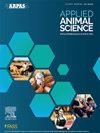Invited Review: Connecting the dots—Calving difficulty, age at first calving, and enhanced cow production*
IF 1.5
Q3 AGRICULTURE, DAIRY & ANIMAL SCIENCE
引用次数: 0
Abstract
Purpose
We aimed to explore the relationships among calving difficulty (CD), production traits, age at first calving (AFC), and culling in dairy cattle.
Sources
Data from 687 US dairy farms, encompassing 1,048,574 CD observations scored from 1 to 5, were analyzed. Scores of CD 5 were adjusted to 4 due to limited interactions with other variables. The focus was on Holstein, Jersey, and dairy cross breeds, and parity was categorized as primiparous or multiparous.
Synthesis
The study comprised 4 steps. Step 1 assessed the effect of CD on milk yield, fat, protein, ECM, and peak milk production with fixed effects of CD, parity, calf sex (CS), and breed and random effects of calving year, calving season, and herd. Step 2 analyzed AFC, using linear and quadratic covariates, on the same parameters. Step 3 examined CD as the response variable in the step 2 database. Step 4 used logistic regression to assess risk factors associated with CD and culling reasons. Our results showed the following. Step 1: CD significantly affected milk yield, ECM, fat, protein, and peak milk production, with declines in production traits for CD >2, the least values at CD 4. Step 2: Significant linear and quadratic AFC covariates showed optimal milk performance at 27 to 28 mo. Step 3: CD was influenced by breed, CS, AFC, and interactions, with minimal CD observed at AFC of 23 to 26 mo. Step 4: Greater CD was linked to culling for nondairy purposes.
Conclusions and Applications
Calving difficulty affects production traits and is influenced by parity, breed, and CS, but its effect is less significant than expected. The AFC, particularly over 26 mo, has a more pronounced effect on CD. Greater CD levels are associated with increased involuntary culling.
特邀评论:连接点-产犊困难,首次产犊年龄,提高奶牛产量*
目的探讨奶牛产犊困难(CD)、生产性状、初产犊龄(AFC)与扑杀之间的关系。来自687个美国奶牛场的数据,包括1,048,574个CD观察结果,得分从1到5,进行了分析。由于与其他变量的交互作用有限,cd5的得分调整为4。重点是荷斯坦、泽西和奶牛杂交品种,胎次被分类为初产或多产。该研究包括4个步骤。步骤1评估乳脂对产奶量、脂肪、蛋白质、ECM和峰值产奶量的影响,其中乳脂、胎次、犊牛性别(CS)和品种的影响是固定的,产犊年份、产犊季节和畜群的影响是随机的。步骤2分析AFC,使用线性和二次协变量,在相同的参数。步骤3将CD作为步骤2数据库中的响应变量进行检查。步骤4使用逻辑回归评估与乳糜泻相关的危险因素和剔除原因。我们的结果显示如下。步骤1:乳糜酐显著影响产奶量、泌乳率、脂肪、蛋白质和峰值产奶量,乳糜酐和乳糜酐对生产性状的影响以乳糜酐和乳糜酐2的影响最大,乳糜酐4的影响最小。步骤2:显著的线性和二次AFC协变量显示,27至28个月时产奶性能最佳。步骤3:乳糜CD受品种、CS、AFC和相互作用的影响,在AFC 23至26个月时观察到最小的乳糜CD。步骤4:较大的乳糜CD与非乳制品目的的扑杀有关。结论与应用规模化难度影响生产性状,受胎次、品种和CS的影响,但其影响程度不如预期显著。AFC,特别是26个月以上,对乳糜泻的影响更明显。乳糜泻水平越高,非自愿扑杀的次数就越多。
本文章由计算机程序翻译,如有差异,请以英文原文为准。
求助全文
约1分钟内获得全文
求助全文

 求助内容:
求助内容: 应助结果提醒方式:
应助结果提醒方式:


